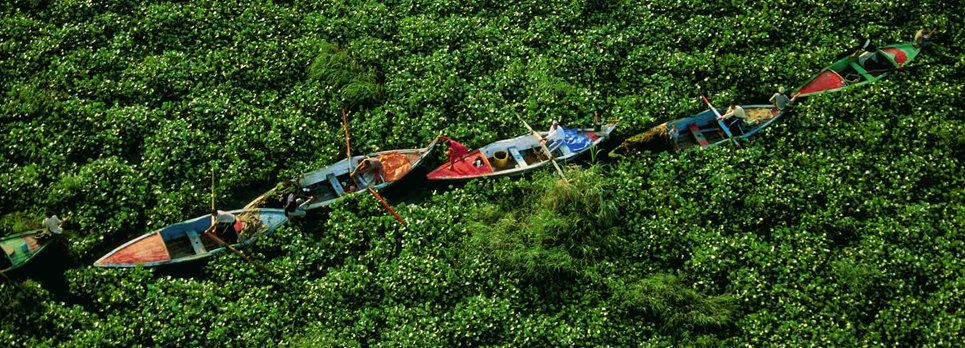
ENVIRONMENTAL IMPACT
Once it proliferates in a water body, E. crassipes dramatically alters the ecosystem and often results in environmental degradation and a reduction in bio-diversity. A number of researchers note that in many water bodies and wetland areas, the encroachment of water hyacinth has reduced or eliminated natural vegetation (Terry, 1996; Kumar and Rohatgi, 1999).
The plant may negatively impact some native species of invertebrates, fish, birds and plants. For example, in Madagascar, many parts of the Alaotra Lake, a site of biological importance, have been reported as covered with carpets of E. crassipes that are detrimental to a number of species, such as the duck Thalassornis leuconotus (Binggeli, 2003).
OTHER ENVIRONMENTAL IMPACTS INCLUDE:
Restricting Water Flow in Rivers, Irrigation and Drainage Channels, thus Reducing Irrigation Water and/or Leading to Greater Risk of Flooding.
Gopal (1987) refers to water flow being reduced by 40-95% in irrigation channels, sometimes leading to flooding in Malaysia and Guyana.
Excess Evapotranspiration, causing Wastage of Water that would otherwise be used for Irrigation, Drinking, Fisheries, etc.
Rates of loss have been reported up to 13 times that from a free water surface, with an average of 2.5 times the loss (Gopal, 1987). In India, the loss of water of the mats of E. crassipes was 7.8 times greater that of open water thus resulting in massive wastage of water especially in dry regions (Vasudevan and Jain, 1991). However, it has recently been claimed that these figures have been grossly exaggerated by inadequate experimental technique (Allen et al., 1997). But it is observed that the level of water in the Victoria Lake has got reduced by One meter compared to that of 1995.
When Water hyacinth Mats Decompose Dissolved Oxygen Levels are Reduced and Sedimentation increases.
The effects of E. crassipes on physicochemical characteristics of water in Lake Naivasha, Kenya, are described by Mironga et al. (2012). Impacts include greater levels of free carbon dioxide, lower pH and lower levels of dissolved oxygen in infested areas than in open water. A similar study in Badagry Creek and Ologe Lagoon, Lagos, Nigeria (Ndimele, 2012) found effects on salinity, conductivity, total hardness and total dissolved solids.
It is suggested that while there are negative impacts on water quality, the ability of E. crassipes to passively absorb heavy metals and nutrients can be put into good use.
SOCIAL IMPACT
Harley et al. (1996) comment that people in Papua New Guinea have died through a combination of reduced nutrition, degraded water, increased disease vectors and generally reduced health, directly related to the degrading effect of water hyacinth on the environment. Dense mats greatly hinder boating by fishermen and may prevent fishing altogether, thus denying the locals their main source of protein and sometimes forcing people to relocate. In extreme cases of competition between E. crassipes and rice crops, fields have been abandoned. In the Lake Victoria Basin, the main negative social impact were identified by interviewees as an increase in certain diseases, difficulties associated with clean water availability and migration of communities (Mailu, 2001).
RISK AND IMPACT FACTORS
Invasiveness
Impact outcomes
Impact mechanisms
Likelihood of entry/control
© 2024 Media Toons- All Rights Reserved.